Greece reopens 2,400-year-old palace where Alexander the Great was crowned
- Oops!Something went wrong.Please try again later.
- Oops!Something went wrong.Please try again later.
- Oops!Something went wrong.Please try again later.
Greece has reopened the ancient palace where Alexander the Great became King of Macedonia some 2,400 years ago after it underwent restoration.
The Palace of Aigai, formally known as the Royal Metropolis of the Macedonians, was the largest building in classical Greece, covering an area of approximately 15,000 square meters, according to the Greek Cultural Ministry.
It was mostly built by Alexander the Great’s father Philip II of Macedonia in the 4th century BCE.
“It is the place where Alexander the Great was crowned king, a short while after his father’s assassination, to start his glorious campaign,” said Greek Prime Minister Kyriakos Mitsotakis at the opening ceremony Friday.
Alexander’s rule saw him conquering a huge area stretching from modern-day Greece to Egypt, Iran, and as far as northern India and central Asia.
His empire, then unseen in Western history, began what historians call the Hellenistic period, lasting from his death to the rise of the Roman Empire.

His conquests set the foundation for the Greek influence in the eastern part of the Mediterranean Sea for the next 1,000 years. Many important texts in this region, including the early versions of the New Testament, were written in Greek.
Romans destroyed the palace in 148 BCE and it was frequently looted in the coming years.
Restoring the birth place of such an impressive empire was no easy task. It took the Greek government 16 years, with help from the European Union and more than 20 million euros ($21.9 million) according to the Greek Cultural Ministry.
“What we are doing today is an event of global importance and international scope,” Mitsotakis said.
Restoration efforts included excavation of the site, documentation and conservation of artefacts discovered. The Greek government restored 1,400 square meters of mosaics, marble flooring and some columns while keeping the general appearance of the ruin, the country’s cultural ministry said.
“The importance of such monuments transcends local boundaries, becoming property of all humanity. And we as the custodians of this precious cultural heritage, we must protect it, highlight it, promote it and at the same time expand the horizons revealed by each new facet,” Mitsotakis said.
For more CNN news and newsletters create an account at CNN.com

